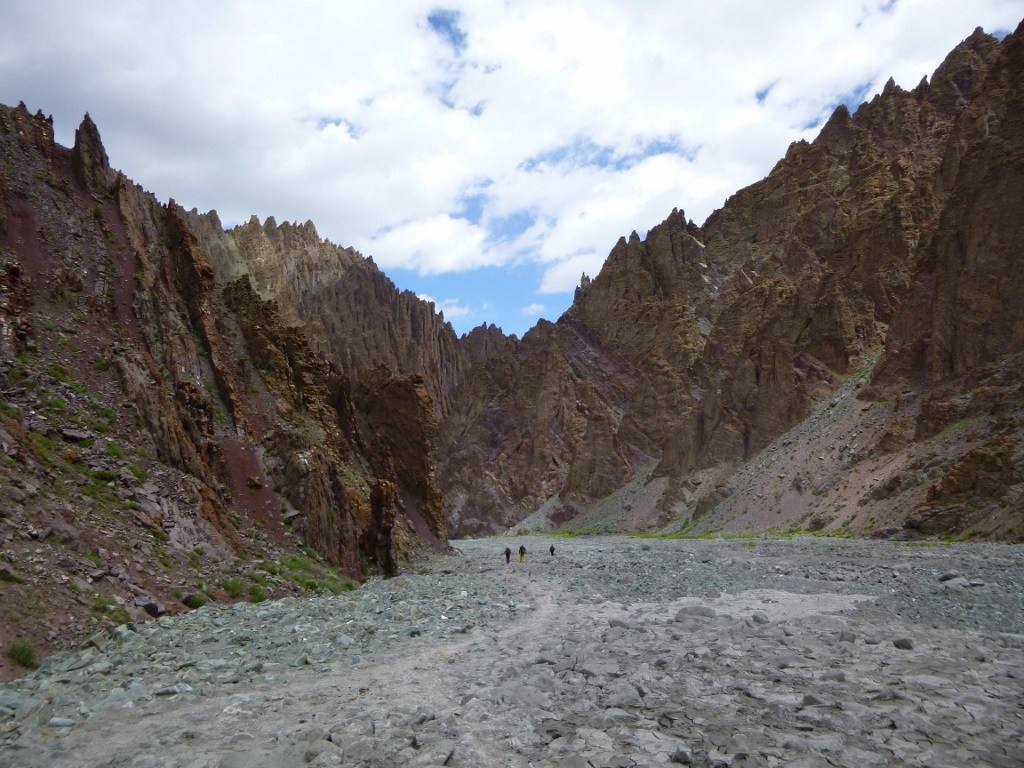The areas of Kinnaur and Spiti were “forbidden land” for foreigners for centuries. Western visitors have only been allowed into this exciting area for a decade. We at Delighted Journey were some of the first visitors to Spiti and have since spent many months in this exciting area. Our journey takes us from the former colonial summer capital of Shimla along spectacular gorges to the barren high valley of Spiti. The majority of Spiti’s just over 10,000 residents are Buddhists.
Following in the footsteps of the Buddhist saint Rinchen Zangpo (958-1055), who was born in Kinnaur, we visit ancient Buddhist monasteries and temple complexes on our journey. Spiti is a fantastic area for easy hikes to small villages, impressive viewpoints and the impressive mountains. The Lingti Valley is known for its many prehistoric fossils.


Best time to travel: mid-September – end of November
Climate and weather:
Spring (March – May)
Warm or hot in the lowlands, often pleasant temperatures in the mountains. Depending on the altitude, the time of rhododendron flowering is very beautiful in April/May. Partly hazy at lower altitudes. Good travel and trekking season.
Monsoon (June – mid-September)
Lots of rain and clouds burst. Lush vegetation. “Dry” areas like Spiti can be visited because they are largely shielded from the monsoon by the high mountains. However, due to the monsoon, there may be delays due to landslides etc. when traveling to these areas.
Autumn (mid-September – end of November)
Ideal travel and trekking time. Clear and dry weather in many cases with temperatures that are not too hot in the lowlands, pleasant temperatures at medium altitudes of 3000 to 4000 meters and cool or cold temperatures at higher altitudes.
Winter (December – February)
Often clear and stable weather. Not too cold in lower altitudes and often pleasant temperatures with sunshine. Good time for cultural and hiking trips or trekking at lower altitudes. Above 3000 to 4000 meters the passes may be blocked due to snow.
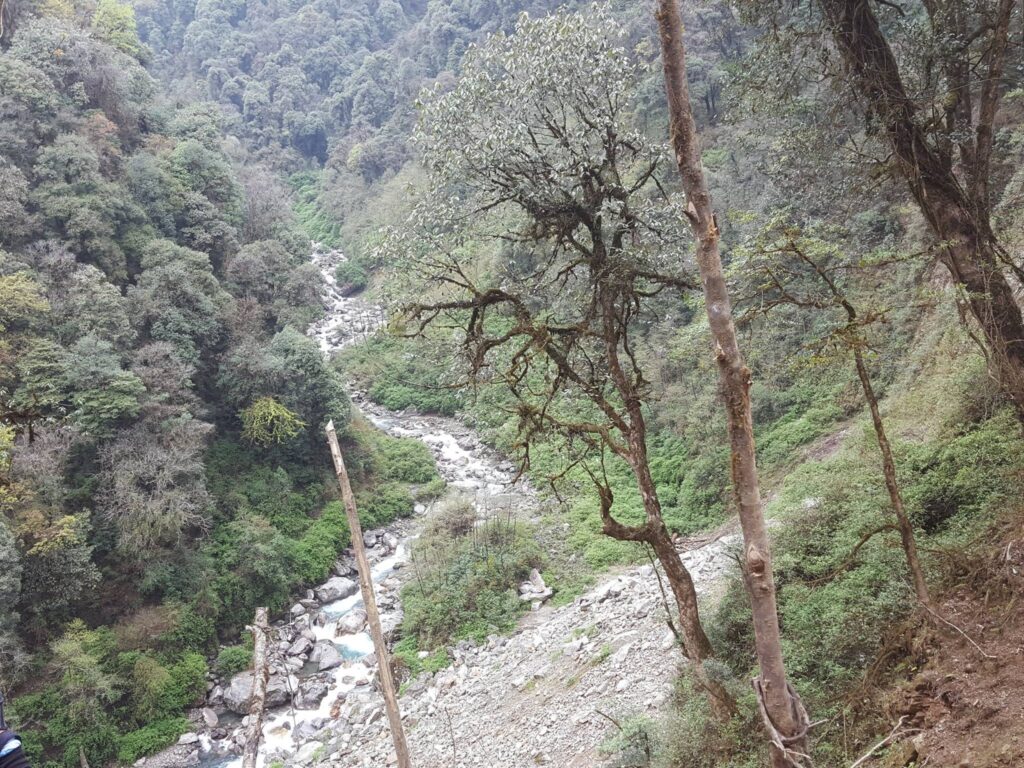
Local English speaking tour guide
This trip is led by a local English speaking guide. He knows very well this part of Indian Himalaya, people and customs and will also translate for us if we come into contact with locals along the way. The local, they often don’t speak English.
Our comment on the trip
A varied journey across the Himalayas. Green, lush landscapes in the pre-Himalayas and barren, Tibetan mountain landscapes in Spiti. Colonial flair in Shimla, simple mountain villages at 4000 meters altitude and magnificent forests in Manali.
Requirements
- Easy round trip with easy day hikes of 1 – 4 hours.
- All hikes are optional and can be skipped.
- The hikes are easy to moderately difficult, but in bad weather it can be slippery, good hiking shoes are recommended.
- We carry our backpacks ourselves on hikes.
- Overland journeys of 2 – 5 hours.
For Our Safety
For our safety we have the following with us:
- Extensive emergency pharmacy
- Pulse oximeter for measuring oxygen in the blood
- Oxygen bottle
Note: Satellite phones are not allowed in India, so we didn’t bring with us. However, our tour guide has a local SIM card for his cell phone and there is network coverage depending on the region (generally not on treks).

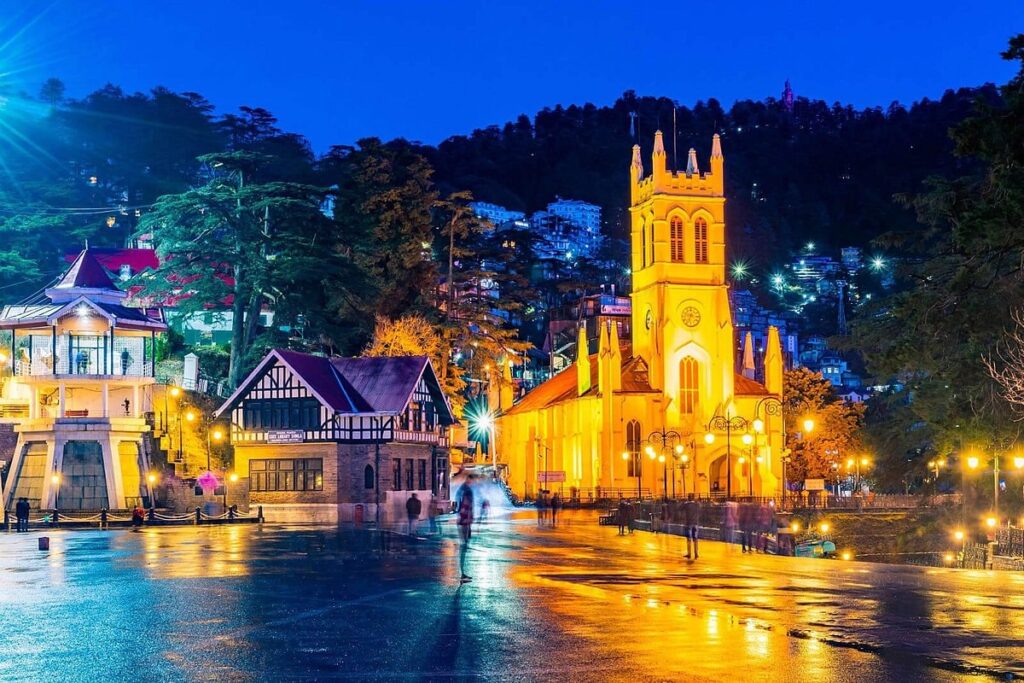
Medical Care
In India, medical care is very simple. In many regions there is no medical care available and we are on our own. That’s why we send along an extensive emergency pharmacy in case of emergencies.
No vaccinations are mandatory for India. However, vaccinations against polio, tetanus, diphtheria and hepatitis are recommended depending on the situation, and depending on the destination and duration of the trip, possibly also typhoid and rabies. Get advice from your family doctor or tropical doctor about vaccinations and medical questions. You may want to have a health check done before your trip.
Traveling at high altitudes
On this trip we move to greater heights. The occurrence of altitude sickness symptoms has less to do with age or personal fitness and more to do with the speed of the climb to high altitudes and one’s own behavior. Our program is put together very carefully to ensure problem-free acclimatization. However, it is possible that in rare cases travel participants may become altitude sick and the trip may even have to be canceled or changed. Thanks to good planning and slow acclimatization, this only happens very rarely on our trips.
Anyone who has had serious altitude problems in the past or suffers from conditions that can make acclimatization difficult (such as angina pectoris, heart and lung disease, etc.) may be at increased risk. If you are not sure, be sure to clarify this with your doctor. We will provide you with a list of specialized altitude doctors who offer preventive examinations.
We will inform you about altitude sickness before the trip and of course you can contact us at any time. With the travel documents you will receive an information sheet for traveling at high altitudes. Be sure to inform us if you have any chronic illnesses or illnesses that could be important for the trip. Please also inform us if you take medication regularly. Not all medications are “altitude compatible” and “suitable for travel”. Discuss this with your doctor in advance.
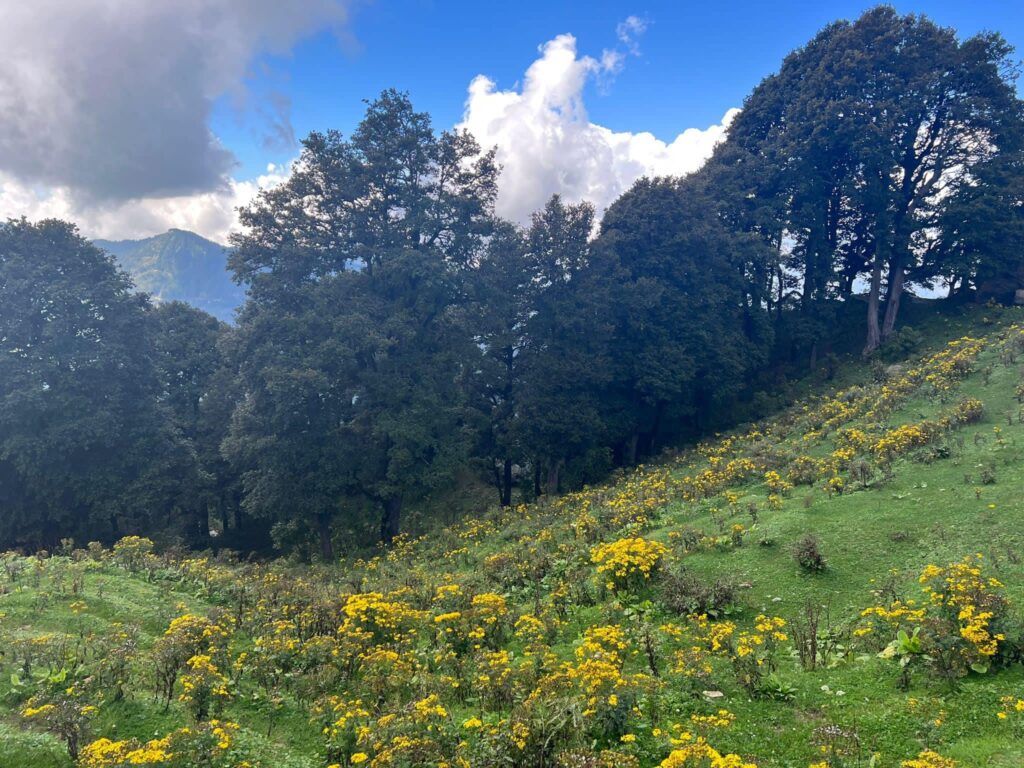
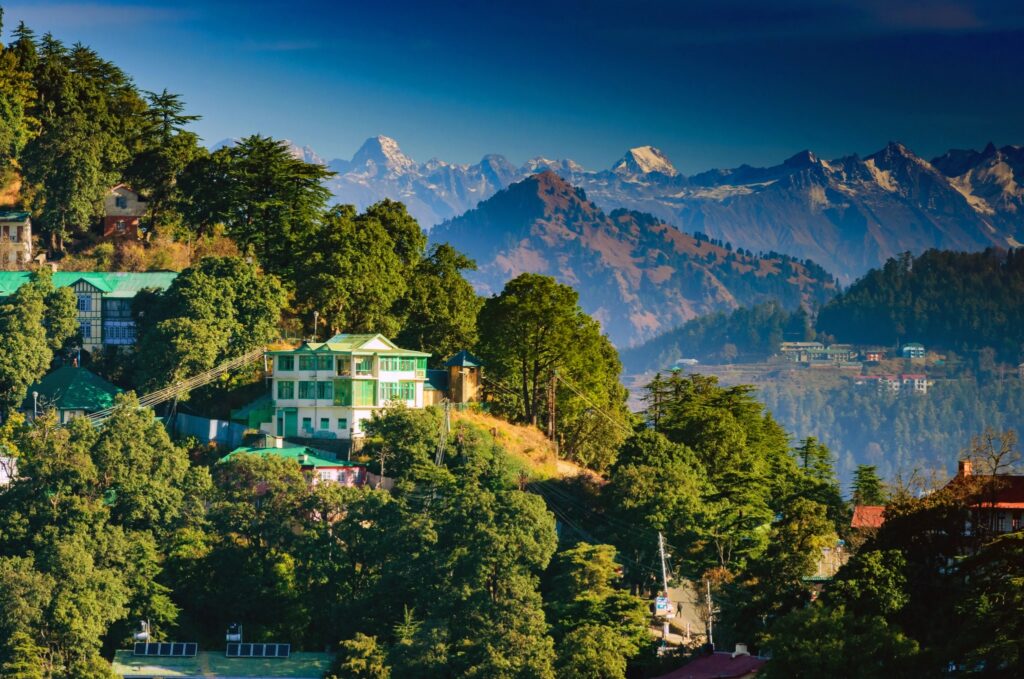
Group Pharmacy
Medical care is not guaranteed in many areas of the Himalayas. We often spend several days far away from medical facilities. That’s why we have an extensive group pharmacy.
Itinerary
Day 1: Arrival New Delhi
Upon arrival at New Delhi International airport. After a customs check, proceed to the arrival hall, where one of our staff welcomes you with a sign of your name. Transfer to hotel, check in for overnight stay.
Day 2: Delhi Sightseeing
After our late arrival, it’s not too early today. After a leisurely breakfast, we visit some of Delhi’s sights such as Humayun Tomb, India Gate, Connaught Place etc. Nowhere can you experience the bustling life of India like in the megacities. Delhi with its many beautiful and not so beautiful impressions is overwhelming. So we enjoy the peace and quiet in the various gardens on our way. Overnight at the hotel in Delhi.
Day 3: Delhi – Kalka (Train) – Toy Train to Shimla
We leave Delhi on the famous Indian Railway. In Kalka we change to the “Toy Train”, a narrow-gauge railway that was built by the English over 100 years ago. This train route has been listed as a World Heritage Site by UNESCO. At an altitude of 2200 meters we reach Shimla, the former summer residence of the British colonial government. From the train station we drive to our hotel, where we will stay for the next two days.
Note: The permit requirements for Kinnaur and Spiti change frequently. If possible, we will of course obtain the permits in advance. However, it may also be the case that we “have to” visit the office in person to issue the permit. If so, then it gives us an exciting insight into Indian bureaucracy. Overnight stay at the hotel in Shimla (2200 meters).
Day 4: Shimla Sightseeing
Early in the morning we take a short hike to the summit of the almost 2500 meter high Jakhu Hill. When the weather is clear, we have a beautiful view of the snow-capped peaks of the Himalayas. There is a small temple on Jakhu Hill in honor of the monkey god Hanuman. His descendants populate the temple area and the entire hill and are diligently fed by the many Indian pilgrims. But be careful, the monkeys can be pretty cheeky. A beautiful hike through the forest takes us to the center of Shimla. At the “Mall” and at the famous “Scandal Point” you can still feel a lot of the colonial flair of this former summer capital of India. In the palace of the former British Viceroy of India we are impressed by the pomp of bygone times. Overnight stay at the hotel in Shimla (2200 meters).
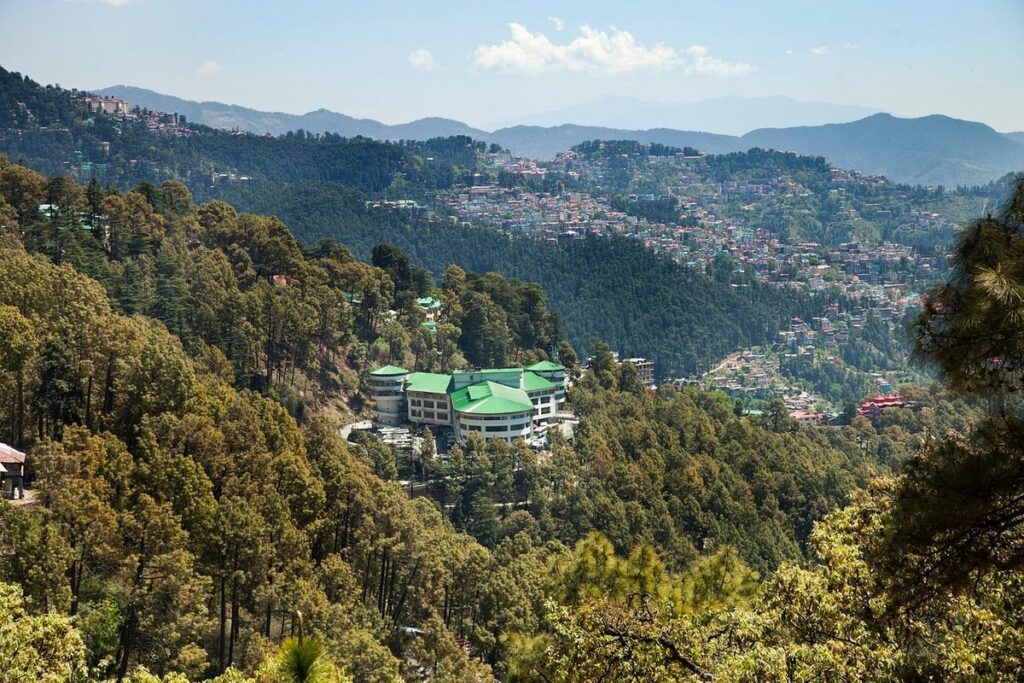
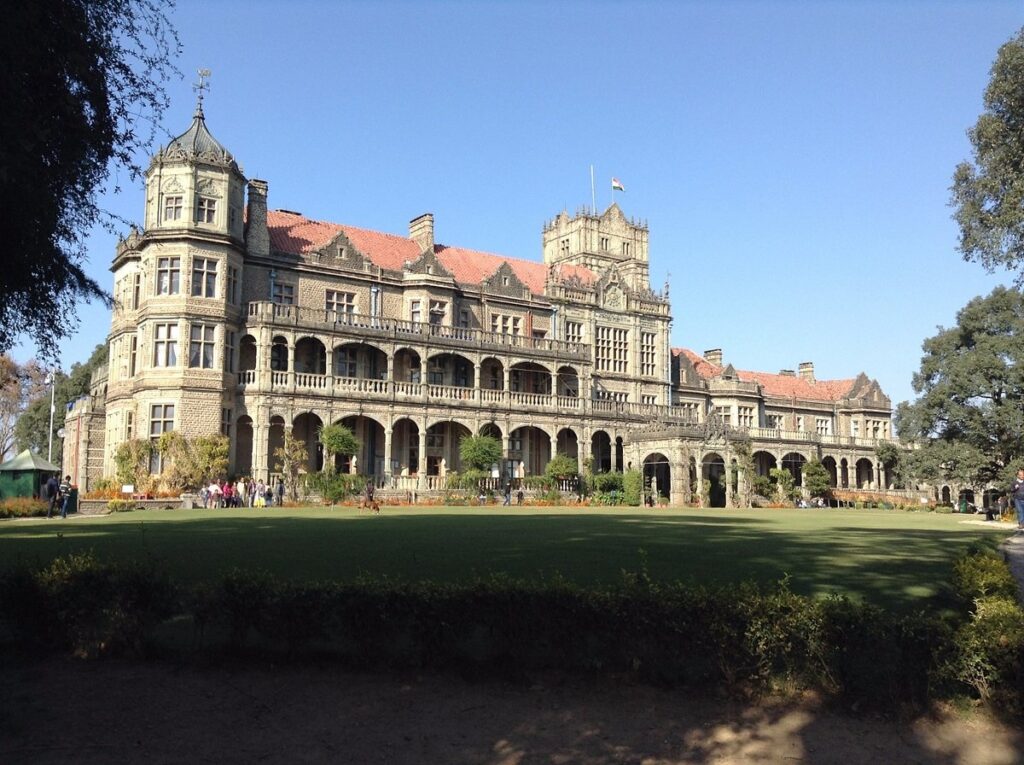
Day 5: Shimla – Sarahan
On the old Hindustan-Tibet route we drive our vehicles along the mighty Sutlej River. This is one of the four rivers that rise from the holy Mount Kailash in Tibet. Our journey goes past forests, terraced fields and small villages. After a long drive we reach our destination today, Sarahan. There we visit the beautiful, wooden Bhimakali Temple. A shiver runs down our spines when we hear that human sacrifices used to be practiced here. Luckily not anymore today and so we have a good chance of surviving the temple visit. If we feel like it, we can then take a stroll through the village or to the lower-lying Buddhist monastery. Overnight stay at the hotel/guest house or homestay in Sarahan (2000 meters).
Day 6: Sarahan – Sangla
Our path takes us deeper and deeper into the Himalayas along the extremely spectacular Sutlej Gorge. After a few hours we branch off into the Baspa Valley, one of the most beautiful valleys in Kinnaur. We reach the small town of Sangla, where we will spend the next two nights. There is a farm in Sangla where saffron is grown. This is considered the most expensive spice in the world and is hand-picked. Saffron is the pistil threads of a type of crocus. Overnight stay at the hotel/guest houe or homestay in Sangla (2700 meters).
Day 7: Sangla – Chitkul – Sangla (Last village before the Tibetan border)
Today we visit Chitkul, the last village before the Tibetan border. Located at almost 3500 meters and with its wooden buildings, it is one of the most peculiar villages in the Himalayas. We explore the valley on a beautiful hike from Rakcham to Batseri. In the evening we return to Sangla. Overnight stay at the hotel/guest house or homestay in Sangla (2700 meters).
Day 8: Sangla – Kalpa
After breakfast we drive to Kalpa. Here we enjoy the beautiful view of the surrounding mountains, including the Kinnaur Kailash, which is over 6,000 meters high. For the people in the area, this is a sacred mountain, even if it does not reach the status of the “real” Kailash in Tibet. We visit the Hu Bu Lan Car Gompa founded by Rinchen Zangpo and the Hindu temple Narayan Nagani. Overnight stay at the hotel/inn in Kalpa (2700 meters).
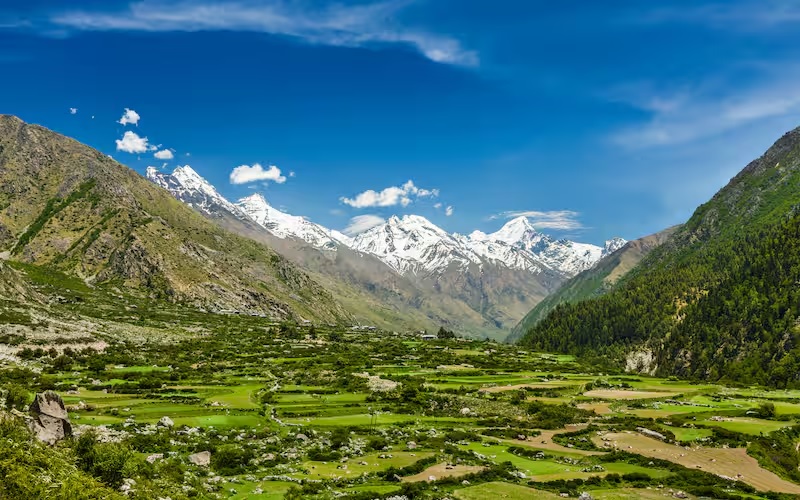
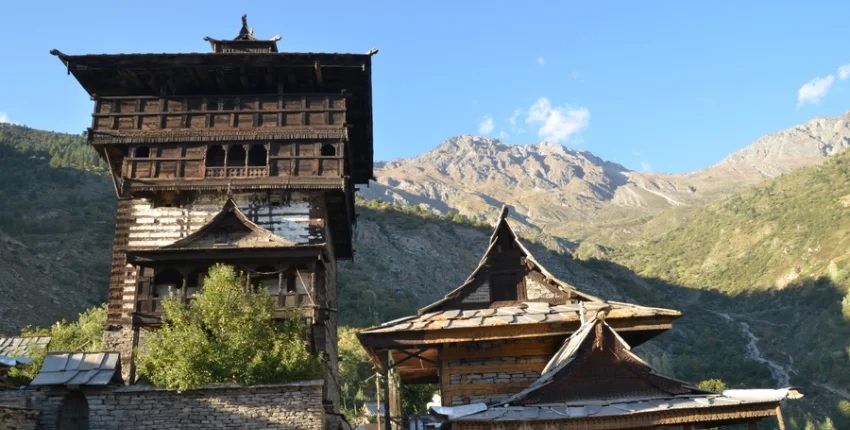
Day 9: Hiking Day
Today we go on a hike in the beautiful surroundings of Kalpa. The afternoon is at leisure. Overnight stay at the hotel/inn in Kalpa (2700 meters).
Day 10: Kalpa – Nako
Our path takes us deeper and deeper into the Himalayas along the extremely spectacular Sutlej Gorge. Towards the evening we reach the small village of Nako with its small but beautiful lake. The residents of Nako are descendants of Tibetans who immigrated long ago. There are some old Buddhist temples in Nako and a footprint of the legendary tantrik Padmasambhava makes it clear to us that Nako may be small today, but has a great past. Overnight stay in the fixed camp/guesthouse or homestay in Nako (2950 meters).
Day 11: Nako – Tabo
On our way to Tabo we drive through the dry high mountain desert to Spiti. If the route is open, take a excursion to Gyu, a tiny village. This place gained regional fame when road workers came across the mummy of a Lama who died 600 years ago. The villagers built a shrine around the found mummy and today this is a place visited with great reverence. In the late afternoon we reach Tabo and visit one of the oldest Buddhist monasteries in the Himalayas. Laid out in the shape of a large mandala, the monastery rooms house wonderful paintings and statues that are said to be up to 1000 years old. This monastery, together with Alchi in Ladakh and Tsaparang in Tibet, is one of the greatest cultural treasures of Buddhist art in the Himalayas. Overnight stay at the hotel/inn in Tabo (3050 meters).
Day 12: Tabo – Dhankar and Lalung Monastery – Kaza
Today we continue to Dhankar, the former capital of Spiti. Imposingly built into the steep rocks, the monastery towers over the village of Dhankar. The whole complex looks more like a castle than a monastery and in earlier, often warlike times, the population retreated here for protection and defense. A hike takes us to a small lake above Dhankar, from where we enjoy a beautiful view. Via Lalung with its small and fine monastery from the time of Rinchen Zangpo (11th century) we drive to Kaza, the small main town of Spiti. Overnight stay at the hotel in Kaza (3600 meters).
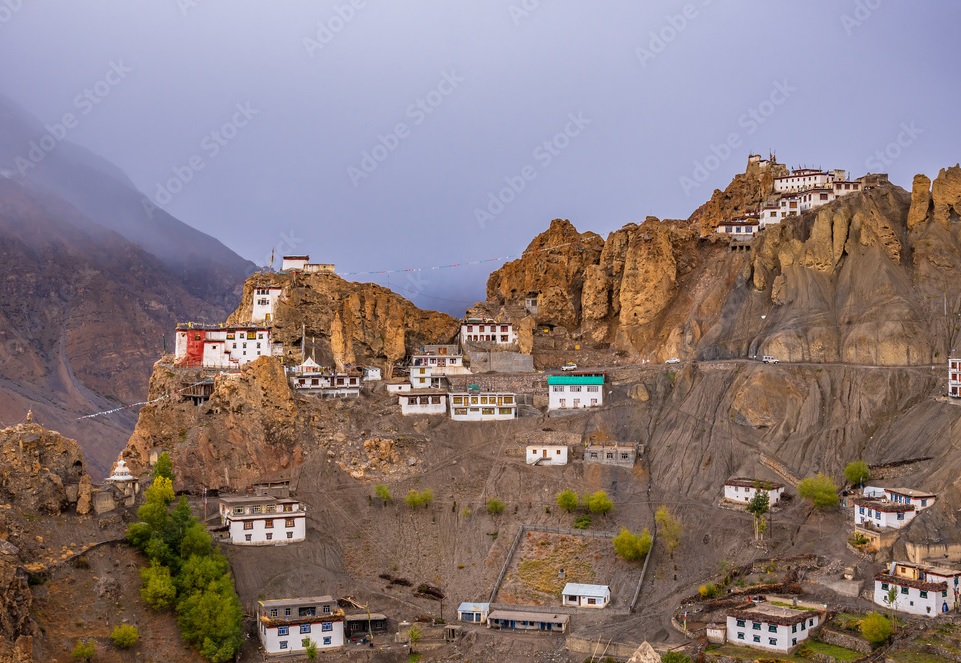
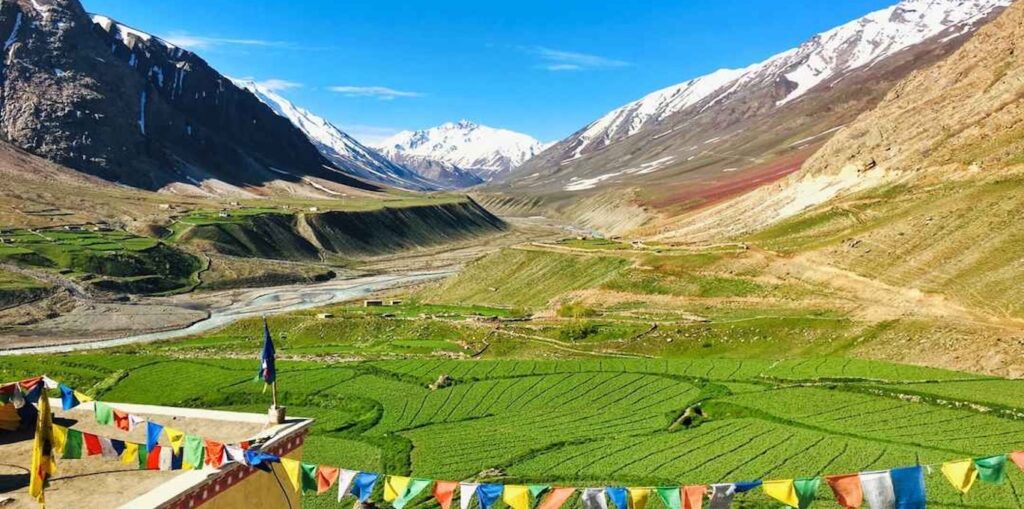
Day 13: Excursion to the Pin Valley, home of the snow leopards
The chance of seeing a specimen of the very rare snow leopard at this time of year is close to zero. Nevertheless, a trip to this rarely visited national park in the Pin Valley is worth it. We pay a visit to the small Kungri monastery. The best riding horses in the Indian Himalayas are said to come from this valley, Ladakh nomads pay a small fortune for these animals. The famous “Butschen” also come from the Pin Valley. Often traveling as wandering monks, some of them have developed tantric skills. During the ceremony they go into a trance and then stick small skewers through their cheeks or throats without injuring themselves. At the end of such a ceremony, a huge boulder of stone is often smashed onto a monk’s stomach. Overnight stay at the hotel in Kaza (3600 meters).
Day 14: Visit some villages
Today we drive on a steep road up into the mountains above Kaza. We go on a lovely hike around the mountain villages of Hikkim, Comic and Langza. Many fossils used to be found here, but today collecting them is forbidden for foreign visitors. After visiting the small mountain villages, we drive back to Kaza in the afternoon. Here we have time to do the last shopping for our trek. Overnight stay at the hotel in Kaza (3600 meters).
Day 15: Hike near the village of Kibber
Today we visited the impressive Kye Monastery, where the Dalai Lama held a Kalachakra ceremony a few years ago. We then continue to the village of Kibber at an altitude of 4200 meters. The beautiful surroundings are ideal for hikes. We reach a particularly beautiful viewing point directly above the high rock face behind the Kye monastery and enjoy an eagle’s view of the monastery, village and fields from above. Overnight stay at the hotel in Kaza (3600 meters).
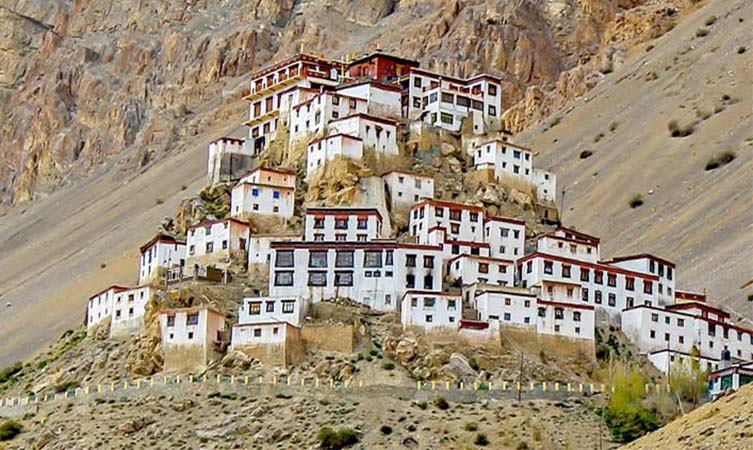
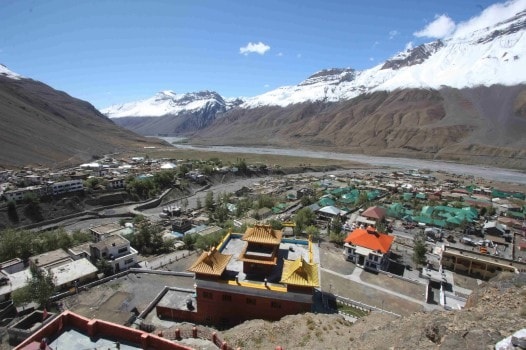
Day 16: Kaza – Manali
An early start is recommended for today’s long journey. Before the Kunzum Pass & Rothang Pass we meet the main road from Manali to Ladakh, which is noticeable in the traffic. There hasn’t been much going on the streets in the last few days, but that’s suddenly changing. But the landscape is also changing, after the days in the desert-like Spiti Valley it is now getting greener and at our destination for the day we enjoy beautiful forests with mighty fir trees. We drive over the Rothang Pass to Manali, a popular place for Indian tourists. The peak season for Indian tourism is April and May, when the Indian plains can become unbearably hot before the monsoon. We enjoy being able to visit this place in the off season. We have the afternoon free. We can enjoy the colorful hustle and bustle in the bazaar. Overnight stay at the hotel in Manali (2000 meters).
Day 17: Manali Sightseeing
Today we have a leisurely day in Manali. A nice walk takes us to the Hadimba Devi Temple with its artistic wood carvings. Legend has it that so that such a beautiful work of art could not be made again, the king at the time had the carver’s right hand cut off. There are also a few other interesting places in the area that we will visit. Overnight stay at the hotel in Manali (2000 meters).
Day 18: Manali – Chandigarh, the city of Le Corbusier
Today we have a long journey ahead of us. We leave the Indian Himalayas and reach the “flatlands” in the evening. Our destination is Chandigarh, this city was designed by the Swiss architect Le Corbusier on behalf of the Indian government. Overnight stay at the hotel in Chandigarh (300 meters).
Day 19: Chandigarh – Rock Garden and return to Delhi
This morning we can visit the famous “Rock Garden” in Chandigarh. At the end of the 1950s, the “road inspector” Nek Chand began collecting waste from industrial society around his small hut and using it to make animal and human figures. Over time, he has created over 20,000 bizarre objects from tiles, neon tubes, oil barrels, clay jugs and much more. Afterwards we drive back to Delhi.Overnight at the hotel in Delhi.
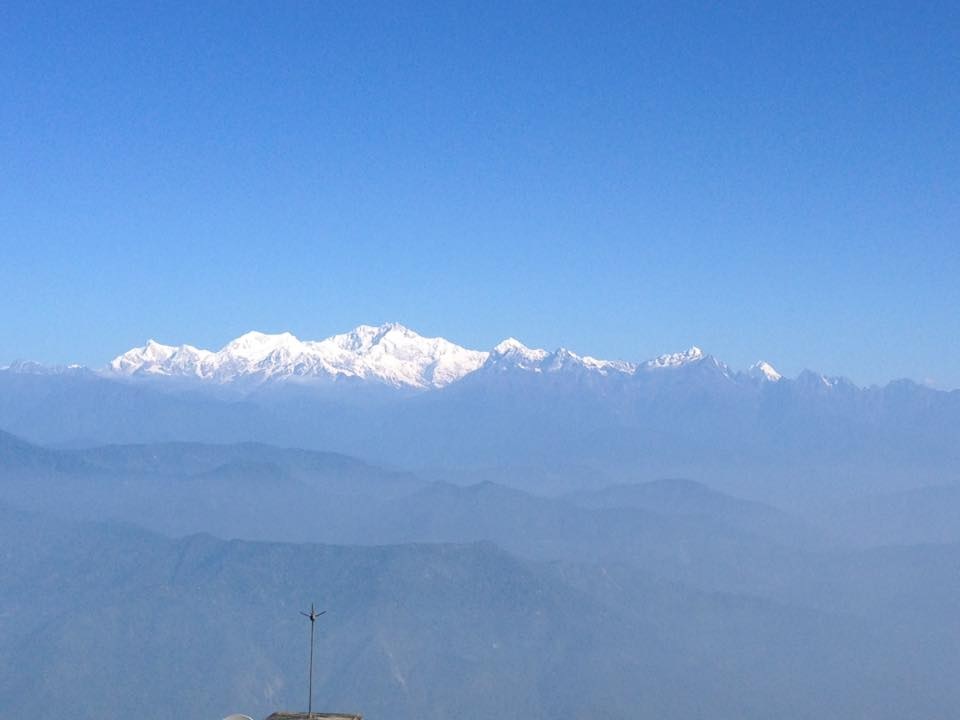
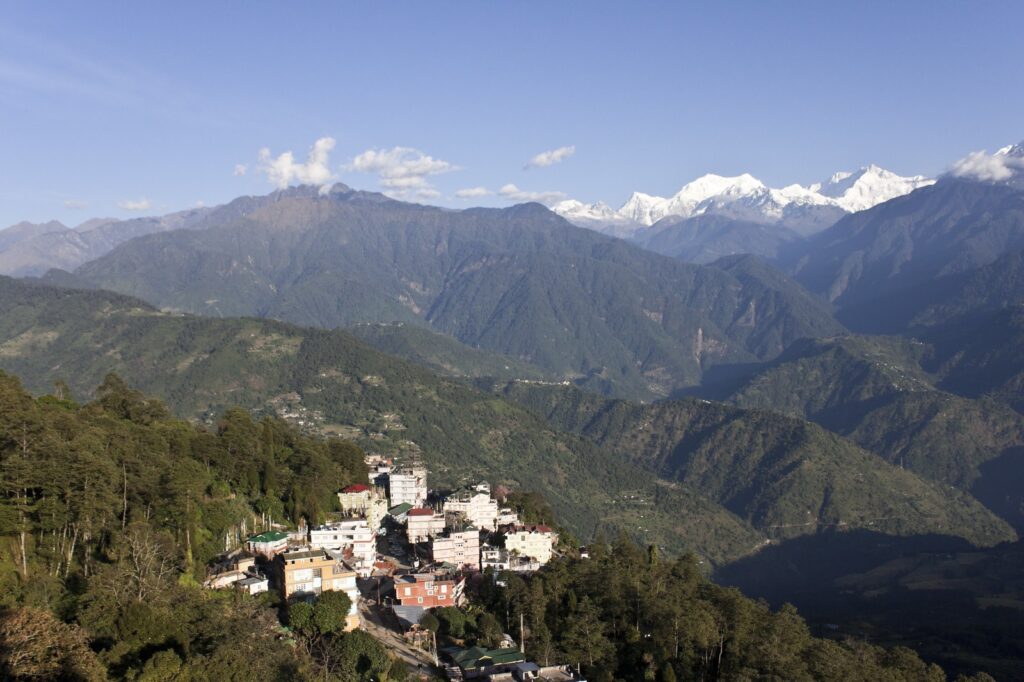
Day 20: Exciting Delhi
After a leisurely breakfast, we let ourselves be surprised by where our tour guide takes us today. We can keep the hotel room until the evening. Over a delicious dinner we reflect on our eventful journey. In the evening we drive to the airport, where we check in for our flight back home.

